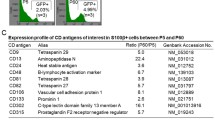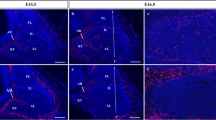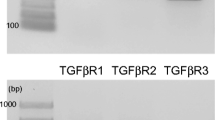Abstract
Approximately 8% of CD9-, S100β- and SOX2-triple positive (CD9/S100β/SOX2-positive) stem/progenitor cells in the anterior lobe of the rat pituitary gland have previously been shown to differentiate into endothelial cells in vitro, suggesting that they play a role in vascularisation as tissue-resident vascular precursor cells. In the present study, we focused on chemokine ligands to further characterise the CD9/S100β/SOX2-positive cells and found that they distinctively express CX3C chemokine ligand 1 (Cx3cl1). Immunohistochemical analysis of the anterior lobe showed that CX3CL1-positive cells comprised 7.8% in CD9-positive cells. By cultivation of the CD9-positive cells on laminin-coated plates, we observed that the expression levels of Cx3cl1 decreased, while those of Sox18, an endothelial cell-progenitor marker, and Cx3cr1, a CX3CL1 receptor, increased. Furthermore, in a rat model of prolactinoma, the most common pituitary tumour, which is accompanied by frequent neo-vasculogenesis in the anterior lobe, we have confirmed a decrease in Cx3cl1 expression and an increase in Cx3cr1 expression, as well as a prominent increase in Sox18 expression. These findings suggest that CX3CL1/CX3CR1 signalling in CD9/S100β/SOX2-positive cells plays an important role in resupplying endothelial cells for vascular remodelling in the anterior lobe.






Similar content being viewed by others
Abbreviations
- ALK:
-
Type I receptors activin receptor- like kinase
- BMP:
-
Bone morphogenic protein
- XCR1:
-
C chemokine receptors
- CCRs:
-
CC chemokine receptors
- CD9/S100β/SOX2-positive:
-
CD9-, S100β- and SOX2-triple positive
- CXCL:
-
CXC chemokine ligand
- CX3CL1:
-
CX3C chemokine ligand 1
- CX3CR1:
-
CX3CL1 receptor
- DES:
-
Diethylstilboestrol
- DIG:
-
Digoxigenin
- FBS:
-
Foetal bovine serum
- HE:
-
Haematoxylin–eosin
- ID:
-
Inhibitor of differentiation
- PB:
-
Phosphate buffer
- P0:
-
Postnatal day 0
- SOX2:
-
Sex-determining region Y-box 2
References
Baggiolini M (1998) Chemokines and leukocyte traffic. Nature 392:565–568
Banerjee SK, De A, Sarkar DK (1994) Colocalization of prolactin and proliferating cell nuclear antigen in the anterior pituitary during estrogen-induced pituitary tumors. Cancer Lett 87:139–144
Bazan JF, Bacon KB, Hardiman G, Wang W, Soo K, Rossi D, Greaves DR, Zlotnik A, Schall TJ (1997) A new class of membrane-bound chemokine with a CX3C motif. Nature 385:640–644
Chakravorty SJ, Cockwell P, Girdlestone J, Brooks CJ, Savage CO (2002) Fractalkine expression on human renal tubular epithelial cells: potential role in mononuclear cell adhesion. Clin Exp Immunol 129:150–159
Fernandes-Cunha GM, Na KS, Putra I, Lee HJ, Hull S, Cheng YC, Blanco IJ, Eslani M, Djalilian AR, Myung D (2019) Corneal wound healing effects of mesenchymal stem cell secretome delivered within a viscoelastic gel carrier. Stem Cells Transl Med 8:478–489
Fujiwara K, Jindatip D, Kikuchi M, Yashiro T (2010) In situ hybridization reveals that type I and III collagens are produced by pericytes in the anterior pituitary gland of rats. Cell Tissue Res 342:491–495
Fujiwara K, Yatabe M, Tofrizal A, Jindatip D, Yashiro T, Nagai R (2017) Identification of M2 macrophages in anterior pituitary glands of normal rats and rats with estrogen-induced prolactinoma. Cell Tissue Res 368:371–378
Harrison JK, Jiang Y, Wees EA, Salafranca MN, Liang HX, Feng L, Belardinelli L (1999) Inflammatory agents regulate in vivo expression of fractalkine in endothelial cells of the rat heart. J Leukoc Biol 66:937–944
Horiguchi K, Fujiwara K, Kouki T, Kikuchi M, Yashiro T (2008) Immunohistochemistry of connexin 43 throughout anterior pituitary gland in a transgenic rat with green fluorescent protein-expressing folliculo-stellate cells. Anat Sci Int 83:256–260
Horiguchi K, Ilmiawati C, Fujiwara K, Tsukada T, Kikuchi M, Yashiro T (2012) Expression of chemokine CXCL12 and its receptor CXCR4 in folliculostellate (FS) cells of the rat anterior pituitary gland: the CXCL12/CXCR4 axis induces interconnection of FS cells. Endocrinology 153:1717–1724
Horiguchi K, Fujiwara K, Higuchi M, Yoshida S, Tsukada T, Ueharu H, Chen M, Hasegawa R, Takigami S, Ohsako S, Yashiro T, Kato T, Kato Y (2014) Expression of chemokine CXCL10 in dendritic-cell-like S100beta-positive cells in rat anterior pituitary gland. Cell Tissue Res 357:757–765
Horiguchi K, Nakakura T, Yoshida S, Tsukada T, Kanno N, Hasegawa R, Takigami S, Ohsako S, Kato T, Kato Y (2016) Identification of THY1 as a novel thyrotrope marker and THY1 antibody-mediated thyrotrope isolation in the rat anterior pituitary gland. Biochem Biophys Res Commun 480:273–279
Horiguchi K, Fujiwara K, Yoshida S, Nakakura T, Arae K, Tsukada T, Hasegawa R, Takigami S, Ohsako S, Yashiro T, Kato T, Kato Y (2018) Isolation and characterisation of CD9-positive pituitary adult stem/progenitor cells in rats. Sci Rep 8:5533
Hosking BM, Wang SC, Chen SL, Penning S, Koopman P, Muscat GE (2001) SOX18 directly interacts with MEF2C in endothelial cells. Biochem Biophys Res Commun 287:493–500
Imai T, Hieshima K, Haskell C, Baba M, Nagira M, Nishimura M, Kakizaki M, Takagi S, Nomiyama H, Schall TJ, Yoshie O (1997) Identification and molecular characterization of fractalkine receptor CX3CR1, which mediates both leukocyte migration and adhesion. Cell 91:521–530
Imaizumi T, Yoshida H, Satoh K (2004) Regulation of CX3CL1/fractalkine expression in endothelial cells. J Atheroscler Thromb 11:15–21
Inoue K, Couch EF, Takano K, Ogawa S (1999) The structure and function of folliculo-stellate cells in the anterior pituitary gland. Arch Histol Cytol 62:205–218
Koga H, Sugiyama S, Kugiyama K, Watanabe K, Fukushima H, Tanaka T, Sakamoto T, Yoshimura M, Jinnouchi H, Ogawa H (2005) Elevated levels of VE-cadherin-positive endothelial microparticles in patients with type 2 diabetes mellitus and coronary artery disease. J Am Coll Cardiol 45:1622–1630
Leis O, Eguiara A, Lopez-Arribillaga E, Alberdi MJ, Hernandez-Garcia S, Elorriaga K, Pandiella A, Rezola R, Martin AG (2012) Sox2 expression in breast tumours and activation in breast cancer stem cells. Oncogene 31:1354–1365
Maciejewski-Lenoir D, Chen S, Feng L, Maki R, Bacon KB (1999) Characterization of fractalkine in rat brain cells: migratory and activation signals for CX3CR-1-expressing microglia. J Immunol (Baltimore, Md: 1950) 163:1628–1635
Papadopoulos EJ, Sassetti C, Saeki H, Yamada N, Kawamura T, Fitzhugh DJ, Saraf MA, Schall T, Blauvelt A, Rosen SD, Hwang ST (1999) Fractalkine, a CX3C chemokine, is expressed by dendritic cells and is up-regulated upon dendritic cell maturation. Eur J Immunol 29:2551–2559
Rajagopal S, Rajagopal K, Lefkowitz RJ (2010) Teaching old receptors new tricks: biasing seven-transmembrane receptors. Nat Rev Drug Discov 9:373–386
Strieter RM, Burdick MD, Mestas J, Gomperts B, Keane MP, Belperio JA (2006) Cancer CXC chemokine networks and tumour angiogenesis. Eur J Cancer (Oxford, England: 1990) 42:768–778
Vanstapel MJ, Gatter KC, de Wolf-Peeters C, Mason DY, Desmet VD (1986) New sites of human S-100 immunoreactivity detected with monoclonal antibodies. Am J Clin Pathol 85:160–168
Walenta KL, Bettink S, Bohm M, Friedrich EB (2011) Differential chemokine receptor expression regulates functional specialization of endothelial progenitor cell subpopulations. Basic Res Cardiol 106:299–305
Winer J, Jung CK, Shackel I, Williams PM (1999) Development and validation of real-time quantitative reverse transcriptase-polymerase chain reaction for monitoring gene expression in cardiac myocytes in vitro. Anal Biochem 270:41–49
Zlotnik A, Yoshie O (2000) Chemokines: a new classification system and their role in immunity. Immunity 12:121–127
Acknowledgements
We are grateful to Dr. Tom Kouki for his excellent technical assistance with TEM. We thank “Joint Usage/Research Center for Endocrine/Metabolism, Institute for Molecular and Cellular Regulation, Gunma University” (www.imcr.gunma-u.ac.jp/activity/activity3) as the source of the antibodies. We are grateful to Miss Kozue Tateno for her excellent technical assistance. We would like to thank Editage (www.editage.jp) for English language editing.
Funding
This work was supported by JSPS KAKENHI (Grant Nos. 16K08475 to K.H., 21380184 to Y.K. and 24580435 to T.K.), by a MEXT-supported Program for the Strategic Research Foundation at Private Universities (2014–2018) and by the Meiji University International Institute for BioResource Research (MUIIR).
Author information
Authors and Affiliations
Corresponding authors
Ethics declarations
Conflict of interest
The authors have no conflicts of interest that might affect the impartiality of this research.
Ethical approval
The current study was approved by the Committee on Animal Experiments of the School of Agriculture, Meiji University, and Kyorin University based on the NIH Guidelines for the Care and Use of Laboratory Animals. This article does not contain any studies with human participants.
Additional information
Publisher's Note
Springer Nature remains neutral with regard to jurisdictional claims in published maps and institutional affiliations.
Electronic supplementary material
Below is the link to the electronic supplementary material.
Rights and permissions
About this article
Cite this article
Horiguchi, K., Fujiwara, K., Yoshida, S. et al. CX3CL1/CX3CR1-signalling in the CD9/S100β/SOX2-positive adult pituitary stem/progenitor cells modulates differentiation into endothelial cells. Histochem Cell Biol 153, 385–396 (2020). https://doi.org/10.1007/s00418-020-01862-0
Accepted:
Published:
Issue Date:
DOI: https://doi.org/10.1007/s00418-020-01862-0




